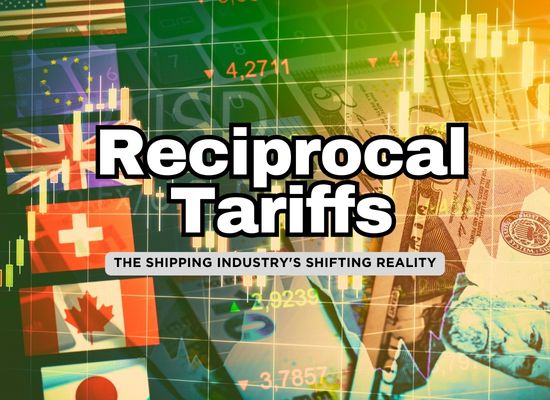Reciprocal Tariffs & Their Impact on Maritime Shipping

Tariffs are a hot topic. Some argue they are necessary, while others see them as a double-edged sword—disrupting supply chains and increasing costs while governments get richer. But we’re not here to take sides. This guide focuses purely on the business impact—specifically, how reciprocal tariffs affect maritime shipping. From freight rates to port congestion, smuggling risks, and shifts in trade routes, we’ll break down the top 20 impacts shaping the industry today.
Each impact is rated as positive, negative, or neutral based on how it influences shipowners, cargo operators, and global trade flows. Keep in mind that there are nuances—for example, an increased demand for trade compliance and legal services may be seen as negative by shipping stakeholders due to added costs and complexity, but positive for law firms and compliance consultants who benefit from the shift.

** We welcome your feedback, suggestions, corrections, and ideas for enhancements. Please email editor at shipuniverse.com **
1️⃣ Increased Shipping Costs
Impact: Negative ❌
Reciprocal Tariffs increase the cost of moving goods across borders, and maritime shipping is no exception. When reciprocal tariffs are imposed, shipping companies face additional expenses that affect profitability and trade volume.
Key impacts:
- Higher customs duties, compliance costs, and administrative fees add to overall expenses.
- Increased costs often get passed down to cargo owners, making imports and exports more expensive.
- Fuel costs may rise as shipping routes become less efficient due to trade restrictions.
- Profit margins shrink, especially in competitive markets where passing costs to customers is difficult.
- Reduced trade volume can lead to lower demand for shipping services.
2️⃣ Disruptions in Trade Routes & Supply Chains
Impact: Negative ❌
Reciprocal tariffs force companies to rethink their supply chains, as once-reliable trade routes become expensive or impractical. This has a ripple effect on maritime shipping, requiring adjustments in logistics, vessel deployment, and port operations.
Key impacts:
- Companies may shift production or sourcing locations, changing established shipping lanes.
- Ports that once handled high volumes of trade may see reduced traffic, while others experience surges.
- Shipping companies must adjust vessel deployment, increasing operational complexity.
- Uncertainty in trade policies makes long-term route planning more difficult.
- Delays and inefficiencies in supply chains can lead to missed delivery deadlines and added costs.
3️⃣ Higher Freight Rates Due to Market Volatility
Impact: Neutral ⚪
Market uncertainty caused by tariffs can lead to fluctuating freight rates. While higher rates can benefit shipping companies in the short term, they can also reduce overall trade volume, making the long-term impact uncertain.
Key impacts:
- Supply chain disruptions create imbalances in demand, leading to unpredictable freight rates.
- Some shipping companies may profit from short-term rate hikes, while others struggle with instability.
- Exporters and importers may delay shipments, waiting for policy clarity, affecting demand.
- Carriers may need to implement surcharges to offset tariff-related costs.
- Market volatility makes it harder for businesses to lock in long-term shipping contracts at stable prices.
4️⃣ Port Congestion from Pre-Tariff Stockpiling
❌ Negative Impact
When new tariffs are announced, companies often rush to move goods before they take effect. This leads to temporary surges in port activity, causing congestion, delays, and inefficiencies.
Key impacts:
- Ports experience temporary surges in cargo volume, overwhelming infrastructure and personnel.
- Ships may face extended wait times for berths, increasing demurrage and detention fees.
- Port congestion disrupts normal trade flow, causing delays in both imports and exports.
- Warehouses near major ports may reach capacity, leading to storage shortages.
- Once the rush subsides, demand may drop, creating an unpredictable shipping cycle.
5️⃣ Decline in Overall Cargo Volume
❌ Negative Impact
Reciprocal tariffs often reduce global trade, leading to a decline in overall cargo volume. As importers and exporters face higher costs, some shipments become unprofitable or unnecessary, directly impacting the shipping industry.
Key impacts:
- Reduced trade results in fewer shipments, lowering demand for maritime transport.
- Some industries, such as manufacturing, may slow production due to higher costs, further decreasing cargo volume.
- Bulk carriers and container ships may struggle with underutilization, leading to higher per-unit costs.
- Lower shipping demand may result in layoffs at ports, logistics firms, and related industries.
- Long-term tariff disputes can lead to structural trade shifts, permanently reducing certain shipping routes.
6️⃣ Growth in Regional Trade & Short-Sea Shipping
✅ Positive Impact
When global trade becomes more expensive due to tariffs, businesses often turn to regional trade and short-sea shipping to avoid higher costs. This shift benefits smaller shipping operators and ports that handle intra-regional cargo movement.
Key impacts:
- Increased demand for regional shipping routes as companies seek tariff-free alternatives.
- Short-sea shipping services become more attractive for cross-border trade within economic blocs like the EU and ASEAN.
- Ports that specialize in regional trade may see an uptick in cargo volume.
- Smaller shipping companies that operate within tariff-exempt zones may experience growth.
- Supply chains become more localized, reducing reliance on long-haul shipping.
7️⃣ Rise in Smuggling & Gray Market Shipping
❌ Negative Impact
Higher tariffs create incentives for illegal trade practices, including smuggling and gray market shipping. Companies and individuals seeking to avoid tariffs may use unregulated or deceptive shipping methods, increasing risks for the industry.
Key impacts:
- Increased enforcement efforts at ports, leading to delays and higher inspection costs.
- Shippers unknowingly transporting illicit goods may face legal consequences and fines.
- Greater reliance on unregulated shipping routes, increasing risks of cargo loss or theft.
- Fraudulent documentation practices may rise, leading to stricter compliance measures for legitimate shippers.
- Heightened security concerns, potentially leading to additional regulations that impact all maritime trade.
8️⃣ Expansion of Tariff-Free Shipping Zones (e.g., FTZs)
✅ Positive Impact
As businesses look for ways to bypass tariffs, free trade zones (FTZs) and special economic zones (SEZs) become more attractive. These areas allow companies to import, store, and process goods without immediately paying tariffs, improving efficiency in global shipping.
Key impacts:
- Increased cargo volume in ports that operate within free trade zones.
- Companies strategically relocate supply chain operations to FTZs to minimize tariff exposure.
- Growth in transshipment activities, where goods are rerouted through tariff-free regions before reaching their final destination.
- More investment in port infrastructure to support expanded FTZ operations.
- Shipping lines may develop new services catering specifically to FTZ-based trade.
9️⃣ Stimulus for Domestic Shipbuilding & U.S.-Flagged Vessels
✅ Positive Impact
Reciprocal tariffs, especially those targeting foreign-built ships, can encourage investment in domestic shipbuilding and increase demand for U.S.-flagged vessels. This is particularly relevant under policies promoting national security and economic independence in maritime industries.
Key impacts:
- Increased government and private sector investment in domestic shipbuilding.
- More demand for U.S.-flagged vessels, especially for cabotage and government-related shipping.
- Potential job growth in shipyards, maritime manufacturing, and maintenance services.
- Challenges in scaling shipbuilding quickly enough to meet demand.
- Higher costs of domestically built vessels compared to foreign counterparts.
🔟 Impact on Bunker Fuel Demand & Pricing
⚪ Neutral Impact
Tariffs influence global trade volume, which in turn affects bunker fuel demand. The impact on fuel pricing is uncertain—lower trade may reduce demand, while inefficiencies from shifting routes and tariffs on fuel itself may drive prices up.
Key impacts:
- If trade volume decreases, overall fuel demand may decline, leading to lower prices.
- Trade disruptions may force ships to take longer routes, increasing fuel consumption.
- Tariffs on fuel imports could raise operational costs for shipping companies.
- Volatility in fuel demand makes long-term pricing predictions difficult.
- Changes in regional fuel availability may affect refueling strategies for global shipping lines.
1️⃣1️⃣ Fluctuations in Maritime Insurance Rates Due to Uncertainty
❌ Negative Impact
Increased uncertainty from shifting trade policies leads to higher risk assessments by insurers. This results in fluctuating maritime insurance rates, affecting shipping companies' ability to forecast costs accurately.
Key impacts:
- Insurers may raise premiums due to unpredictable trade disruptions and legal risks.
- Higher insurance costs impact cargo owners, shipping operators, and logistics providers.
- Increased risk of claims from cargo delays, abandoned shipments, or legal disputes.
- Pressure on smaller shipping companies that may struggle with rising insurance expenses.
- Potential for insurers to introduce new coverage options or tariff-related policy adjustments.
1️⃣2️⃣ Increased Demand for Trade Compliance & Legal Services
✅ Positive Impact
As tariffs introduce new complexities in trade, businesses turn to compliance experts and legal professionals to navigate regulations. This creates opportunities for firms specializing in customs law, tariff classification, and trade policy consulting.
Key impacts:
- More demand for legal and consulting services related to tariff compliance.
- Growth in third-party compliance firms offering services to shipping and logistics companies.
- Increased investment in digital compliance solutions and automated customs processing.
- Longer processing times for cargo as companies ensure adherence to new regulations.
- Higher costs for businesses that must invest in compliance to avoid penalties.
1️⃣3️⃣ Greater Competition Among Ports Seeking Trade Diversion Benefits
✅ Positive Impact
When tariffs disrupt existing trade flows, ports compete to attract diverted cargo. Many ports invest in infrastructure upgrades and offer incentives to shipping companies, leading to modernization and improved efficiency.
Key impacts:
- Ports develop new infrastructure to handle increased cargo volume from diverted trade.
- Governments and port authorities introduce tax breaks and reduced fees to attract shippers.
- Increased investment in automation and logistics technologies to streamline operations.
- Some smaller or lesser-used ports may experience a surge in traffic, leading to economic growth.
- Ports that fail to adapt may lose business, shifting trade dominance to more flexible locations.
1️⃣4️⃣ More Complex Customs Clearance & Processing Delays
❌ Negative Impact
Reciprocal tariffs add layers of bureaucracy to customs processing, leading to increased wait times and higher compliance costs. This slows trade movement and creates inefficiencies in global shipping.
Key impacts:
- Additional paperwork and verification steps increase customs clearance times.
- Higher likelihood of cargo inspections, adding further delays.
- Increased costs for shippers who must hire customs brokers or legal experts.
- Risk of perishable goods being impacted by prolonged clearance times.
- Some companies may shift to alternative trade routes to avoid overly complex customs processes.
1️⃣5️⃣ Container Shortages & Imbalances in Global Trade
❌ Negative Impact
Reciprocal tariffs disrupt established trade routes, leading to mismatches in container supply and demand. Some regions experience container shortages, while others accumulate excess empty containers, creating inefficiencies.
Key impacts:
- Cargo-ready ports may experience shortages of empty containers, delaying shipments.
- Overloaded ports struggle with storing and repositioning excess empty containers.
- Increased costs for shippers forced to pay premiums for available containers.
- Longer turnaround times for shipping companies that must reposition containers manually.
- Potential for new investment in regional container manufacturing and leasing services.
1️⃣6️⃣ Shift in Cargo Composition (More Raw Materials, Fewer Finished Goods)
⚪ Neutral Impact
Tariffs often target finished goods more than raw materials, causing a shift in what types of cargo are shipped globally. This can benefit some shipping sectors, such as bulk carriers, while negatively impacting others, like containerized freight.
Key impacts:
- Increased demand for bulk carriers as raw material shipments remain strong.
- Reduced demand for containerized shipping if finished goods trade declines.
- Some manufacturers may relocate production closer to consumer markets, altering shipping demand.
- Potential new trade opportunities for countries specializing in raw material exports.
- Short-term disruptions as businesses adjust to new trade patterns.
1️⃣7️⃣ More Ships Laid Up or Idled Due to Weaker Demand
❌ Negative Impact
As tariffs reduce trade volume, some shipping companies struggle to fill cargo holds, leading to idle or laid-up vessels. This directly impacts profitability and creates excess capacity in the market.
Key impacts:
- Reduced global trade results in lower demand for cargo transport.
- Shipping companies may temporarily lay up vessels to cut operational costs.
- Overcapacity in the industry leads to lower freight rates and squeezed profit margins.
- Crew layoffs and reduced port activity negatively impact maritime employment.
- Some companies may scrap older vessels earlier than planned to manage excess supply.
1️⃣8️⃣ Higher Risk of Retaliatory Tariffs on Maritime Services
❌ Negative Impact
Tariffs don't just impact cargo—they can also extend to maritime services, such as shipping insurance, logistics, and port fees. If other countries retaliate against U.S. tariffs, global shipping services could face increased costs.
Key impacts:
- Higher operational costs for shipping lines facing retaliatory port fees or levies.
- Increased complexity in securing insurance coverage for cross-border shipping.
- Countries may prioritize domestic shipping firms, limiting foreign operators' market access.
- Maritime service providers may need to adjust pricing models to offset new costs.
- Some businesses may shift toward regional shipping to avoid international tariffs.
1️⃣9️⃣ Acceleration of Digital & Automated Shipping Solutions
✅ Positive Impact
As companies seek ways to reduce costs and improve efficiency amid tariff challenges, investment in digitalization and automation accelerates. Technologies such as AI-driven logistics, automated customs processing, and blockchain-based trade documentation gain traction.
Key impacts:
- Increased adoption of digital customs clearance systems to streamline compliance.
- AI-powered logistics platforms optimize routes and reduce fuel consumption.
- Automation in ports speeds up cargo handling and reduces reliance on manual labor.
- Blockchain-based trade documentation enhances transparency and security.
- Companies invest in smart shipping solutions to remain competitive in a tariff-heavy trade environment.
2️⃣0️⃣ Long-Term Restructuring of Global Maritime Trade Patterns
⚪ Neutral Impact
Reciprocal tariffs can cause permanent shifts in global shipping patterns. Over time, companies adapt by changing sourcing locations, manufacturing hubs, and trade routes, leading to a structural transformation in maritime trade.
Key impacts:
- Some countries lose shipping volume as companies relocate supply chains to tariff-friendly nations.
- Ports in key transshipment hubs may see long-term increases or declines in traffic.
- Shipping alliances and partnerships may shift based on changing trade priorities.
- Growth in nearshoring and reshoring reduces reliance on long-haul shipping.
- The maritime industry must continuously adapt to evolving trade policies.
Reciprocal tariffs create winners and losers in maritime shipping. While some sectors benefit from new trade patterns, regional growth, and digital innovation, the majority struggle with declining cargo volumes, increased costs, and unpredictable regulations.
Shipping companies, port operators, and maritime service providers must stay agile in this evolving landscape. Those that adapt quickly—whether by optimizing routes, investing in automation, or leveraging tariff-free zones—will be better positioned for long-term success. In an industry built on global trade, understanding the full impact of tariffs is essential for making informed decisions. As policies continue to evolve, maritime businesses must navigate these changes strategically to stay competitive in the years ahead.
Table Summary
| ShipUniverse: Impact of Reciprocal Tariffs on Maritime Shipping | |||
|---|---|---|---|
| Impact | Effect | Description | Business Insight |
| Increased Shipping Costs | ❌ | Tariffs raise transportation costs due to higher customs duties, compliance fees, and administrative expenses. | Shippers struggle to absorb these costs, leading to higher freight rates or reduced profit margins. |
| Disruptions in Trade Routes & Supply Chains | ❌ | Shippers must constantly adjust routes due to changing trade policies, increasing unpredictability. | Unstable shipping lanes make long-term logistics planning difficult, forcing companies to reroute cargo. |
| Higher Freight Rates Due to Market Volatility | ⚪ | Uncertainty in trade policies creates imbalances in shipping demand, leading to fluctuating freight rates. | Some carriers benefit from short-term rate spikes, but unpredictable rates make long-term planning difficult. |
| Port Congestion from Pre-Tariff Stockpiling | ❌ | Companies rush to ship goods before tariffs take effect, overwhelming ports and causing delays. | Congestion leads to higher demurrage fees, increased wait times, and supply chain disruptions. |
| Decline in Overall Cargo Volume | ❌ | Less trade means fewer shipments, reducing demand for shipping services across the industry. | Lower volumes impact port activity, ship utilization, and overall profitability for carriers. |
| Growth in Regional Trade & Short-Sea Shipping | ✅ | As long-haul trade becomes more expensive, companies turn to regional and short-sea shipping alternatives. | Smaller shipping operators benefit from increased demand for regional cargo movement. |
| Rise in Smuggling & Gray Market Shipping | ❌ | High tariffs encourage illegal trade methods, leading to increased smuggling and fraudulent shipping practices. | Governments may tighten enforcement, leading to additional customs inspections and shipping delays. |
| Expansion of Tariff-Free Shipping Zones (e.g., FTZs) | ✅ | Businesses move operations to free trade zones to avoid tariffs, increasing cargo traffic in these regions. | Ports within FTZs attract more investment, benefiting from higher cargo volumes and trade activity. |
| Stimulus for Domestic Shipbuilding & U.S.-Flagged Vessels | ✅ | Tariff policies encourage investment in domestic shipbuilding and increase demand for U.S.-flagged vessels. | More jobs and economic growth for the U.S. maritime industry, though domestic ships remain costly. |
| Impact on Bunker Fuel Demand & Pricing | ⚪ | Less trade reduces fuel demand, but inefficiencies from rerouting ships may increase consumption. | Fuel prices may fluctuate unpredictably, affecting shipping costs and operational planning. |
| Fluctuations in Maritime Insurance Rates Due to Uncertainty | ❌ | Unpredictable trade policies increase risk perception among insurers, leading to fluctuating insurance premiums. | Higher premiums raise costs for shippers, adding financial pressure on cargo owners and logistics firms. |
| Increased Demand for Trade Compliance & Legal Services | ✅ | New tariffs create a complex regulatory environment, increasing demand for compliance specialists and trade lawyers. | Firms specializing in customs, tariffs, and trade policy see a surge in business as companies seek to navigate new regulations. |
| Greater Competition Among Ports Seeking Trade Diversion Benefits | ✅ | Ports compete to attract cargo from tariff-affected trade routes, leading to increased investment and infrastructure improvements. | Some ports experience a boom in business, while others see reduced traffic depending on their ability to adapt. |
| More Complex Customs Clearance & Processing Delays | ❌ | Tariffs introduce additional customs requirements, leading to longer processing times and bureaucratic delays. | Companies must allocate more resources for customs compliance, increasing shipping costs and transit times. |
| Container Shortages & Imbalances in Global Trade | ❌ | Shifts in trade flows cause empty containers to pile up in some ports while others face shortages. | Shippers face increased costs for repositioning empty containers, leading to inefficiencies in global logistics. |
| Shift in Cargo Composition (More Raw Materials, Fewer Finished Goods) | ⚪ | Tariffs typically hit finished goods harder than raw materials, causing shifts in global trade patterns. | Bulk carriers may benefit from increased raw material shipments, while container shipping faces declines. |
| More Ships Laid Up or Idled Due to Weaker Demand | ❌ | Lower trade volumes result in reduced shipping demand, forcing some vessels to be laid up or idled. | Shipping companies may retire older vessels early, cut fleet sizes, or look for alternative markets. |
| Higher Risk of Retaliatory Tariffs on Maritime Services | ❌ | If countries retaliate, tariffs could extend beyond goods to include maritime services, insurance, and port fees. | Shipping costs increase as additional fees and restrictions impact cross-border maritime operations. |
| Acceleration of Digital & Automated Shipping Solutions (to Cut Costs) | ✅ | Tariffs force companies to find cost-cutting measures, accelerating the adoption of digital shipping solutions. | AI, blockchain, and automated customs clearance become more prevalent as companies seek efficiency. |
| Long-Term Restructuring of Global Maritime Trade Patterns | ⚪ | Reciprocal tariffs drive long-term shifts in trade routes, supply chains, and global shipping alliances. | While some regions gain new trade opportunities, others lose prominence as trade patterns evolve. |

Do you have a Maritime Product or Service that may be of interest to Shipowners? Tell us about it here!
Do you have feedback or insights? Please reach out to editor @ shipuniverse.com



